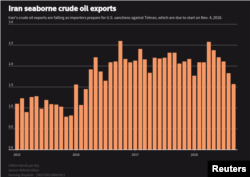LAUNCESTON, Australia, Oct 25 (Reuters)
The crude oil market is still uncertain over the likely impact of the renewed U.S. sanctions against Iran, but two things seem to be becoming clearer: Iran is struggling to keep buyers, and much of the crude it is shipping is being stored.
While not quite a death knell for Iranian exports, news that China's two biggest state refiners, Sinopec Group and China National Petroleum Corp (CNPC), have decided not to take any November-loading cargoes from Tehran is a serious blow.
China is the biggest buyer of Iranian crude and largely stood with the Islamic republic during the previous round of sanctions against its exports.
Sinopec and CNPC, though, are now skipping bookings for November because of uncertainty over whether they can secure U.S. waivers that allow their purchases to continue, Reuters reported on Wednesday.
From Nov. 4, the United States will re-impose sanctions against Iranian crude exports as part of President Donald Trump's efforts to force Tehran to accede to a more restrictive deal on limiting its nuclear and missile programs.
While crude oil market participants don't expect that U.S. sanctions will shut down Iran's exports completely, there is still debate over how much oil is likely to be lost, and for how long the situation will persist.
What China does is key in this regard, given that it imported about 650,000 barrels per day (bpd) of Iranian crude in the first nine months of the year, according to vessel-tracking and port data compiled by Refinitiv.
Iran's crude exports have been in the region of about 2 million bpd in recent months, and it appears to be on track to record shipments around that level in October.
Iranian tankers are routinely turning off their tracking transponders, presumably to disguise their destinations, making it challenging to monitor the true state of the nation's exports.
Even taking that into account, it's worth noting that of the nine cargoes shown as arriving at their destinations in November, six are heading to China, one each to India and Greece, and one to an as yet undetermined Asian port.
IRANIAN CRUDE GETS STORED
There are also questions over what exactly is happening to the Iranian crude arriving in China.
Much of the crude is heading to the northern port of Dalian, where it is likely to end up in bonded storage. That would mean it would be in China, but wouldn't have cleared customs, and therefore unavailable to domestic refiners.
This raises the possibility that some of Iran's crude exports are in or are headed into storage tanks and are effectively lost to the market.
This leads to a couple of points to consider, firstly that the market is adjusting quite well already to the loss of Iranian barrels, and secondly that the oil in storage at some point will come to market, which may depress demand from other suppliers when this happens.
Iran's other key customer is India, which took about 568,000 bpd in the first nine months of the year, according to the Refinitiv vessel-tracking data.
This has yet to decline, with October on track for about 558,000 bpd, but there are indications this may be the high-water mark for a while.
Reliance Industries, which owns the world's largest refining complex, said on Oct. 17 that it has halted imports of Iranian crude and would buy from other Middle Eastern producers and the United States instead.
Other Indian refiners are still aiming to secure U.S. waivers for Iranian imports, but questions over insurance coverage may also force them to limit those shipments.
Overall, it appears both China and India are cutting back on buying crude from Iran, but by how much and for how long still has to be determined.
It also appears that much of Iran's crude is headed into storage and not really available to the market.
While this will put pressure on Iranian government revenues, it raises the possibility, too, of a crude glut once the U.S. sanctions are finally eased.
By Clyde Russell (Editing by Tom Hogue)






